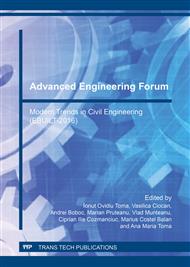p.86
p.94
p.102
p.108
p.116
p.122
p.129
p.135
p.141
Considerations on Using the Strut and Tie Method for Modelling Coupling Beams
Abstract:
This paper presents a synthesis of the numerical analyses regarding the method of modelling the coupling beams of structural walls. The directions of the struts and ties are established according to the results obtained after a linear-elastic finite element analysis. The results obtained after modelling using the Strut and Tie Method, with the struts and ties oriented along the diagonals of the coupling beam, coincide with the results obtained by applying the theory provided by EC8, which proves the viability of the method. This is also confirmed by the results obtained after a non-linear analysis was carried out in the LUSAS finite element environment.
Info:
Periodical:
Pages:
116-121
Citation:
Online since:
March 2017
Authors:
Keywords:
Price:
Сopyright:
© 2017 Trans Tech Publications Ltd. All Rights Reserved
Share:
Citation:


